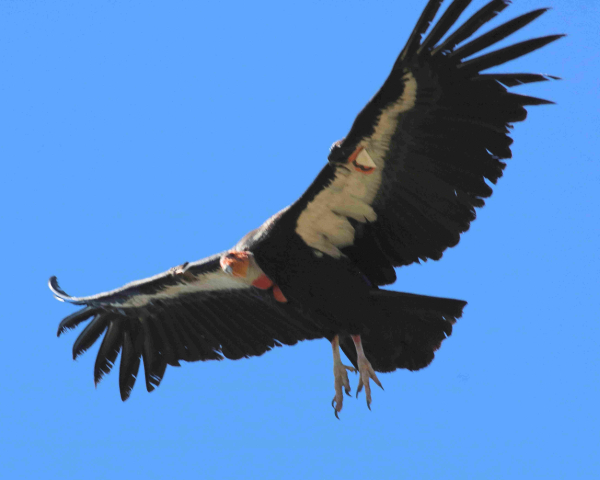
A Black Oystercatcher is a great find along beaches and rocky shores.

The size of a California Condor is best appreciated when close. Condors sometimes drop their feet to help stabilize their gliding flights.

Watch for a variety of shorebirds along the coast, including a Black Turnstone.
|
Along the central coast of California, the beauty of the Pacific Ocean is ever present, as are the precipitous cliffs and pine-forested mountains on opposite sides of Pacific Coast Highway (aka Highway 1 or PCH). As you drive northward from Morro Bay toward Carmel, birding opportunities are exceptional, especially when you consider that this drive provides one of the best options to find super-rare wide-ranging California Condors. Along the way, you can also find Black Oystercatchers, Heermann’s and Western Gulls, Acorn Woodpeckers, Yellow-billed Magpies, Chestnut-backed Chickadees, Lawrence’s or Lesser Goldfinches, plus a White-tailed Kite or Peregrine Falcon.
Add more common species like Red-tailed Hawks, Western Scrub Jays, California Thrashers, Oak Titmice, California Towhees, Western Meadowlarks, and you’re golden. On the north end of Condor Alley lies the trendy city of Carmel, and Monterey just beyond it. Of course, you can cover the same ground by starting in Monterey and driving south; but for this trip, we’ll drive Highway 1 from south to north. The route has many curves and twists to be aware of, and for me it’s always been a bit scary driving along the cliffs, even with a guard rail; for others steep drop-offs are part of the attraction.
In the San Simeon area there is a nice pullout where you can stop to check for Northern Elephant Seals, but it’s also a good place to scan for shorebirds, terns, and gulls. After that, you won’t see any more towns, although there are plenty of locations to pull off the highway to search for birds. When you’re scanning the ocean for birds, watch for dolphins and whales too, and don’t forget about condors!
California Condors tend to hug the coastline, gliding on updrafts along the steep cliffs, although they can also be seen soaring overhead when wind conditions permit. Condors look for carrion along the beach, covering long distances when they wish to. At the same time, you may get really lucky and catch them loafing or roosting in a tree, so keep your eyes peeled. The greater Big Sur area is really a center for Condor activity, and it offers memorable scenes and sights, condors or not.
Condors are very rare – anywhere – but if you find one or more California Condors along PCH, you will be immediately impressed by their size and usually motionless gliding flight. Seeing a condor is unlike seeing a vulture – you will find that condors hold your attention and command you to follow their every move as long as they’re in sight, and you will always remember each time you viewed and photographed them first hand. But be careful; if you have already been in the company of condors, you know they make you want to return to the realm of the condor repeatedly.
A great addendum to Condor Alley is a stop in Monterey, one of the finest cities on the West Coast, but for birding, the area near the aquarium and to the south is an attraction for birders – depending on the season you visit, you may see some seabirds including wintering loons (Red-necked, Common, or Pacific Loons), and shorebirds including Black Turnstones, Black-bellied Plovers, Semipalmated Plovers, and many more – and keep an eye out for Sea Otters, California Sea Lions, and Harbor Seals.
If you have the time and inclination, it’s the ultimate Monterey birding experience to go seabirding on one of Debi Shearwater’s day cruises. That option will take some advance planning, and it’s usually limited to the months of August thru October – when seabirding offshore is best (see http://www.shearwaterjourneys.com/).
Like any other aspect of birding, finding a California Condor, or several of them, is not a sure thing – anywhere. But Condor Alley is certainly a good option to try, and if you don’t find a condor on your first try, you may be compelled to try again – maybe even during your return trip the next day.
Article and photographs by Paul Konrad
Share your birding experiences at editors2tbw@gmail.com